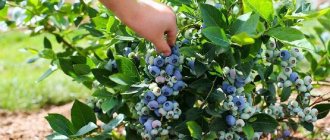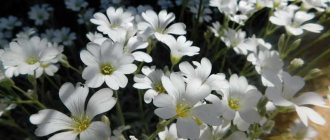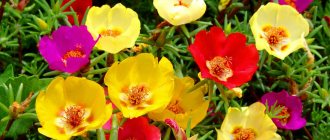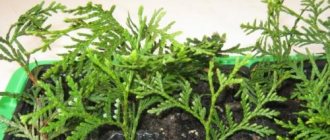Spring-blooming colchicums
Spring colchicums are almost exotic flowers. They differ in that leaf growth begins simultaneously with the flowering process. Peak flowering occurs in May, fruiting begins in early summer, and the flowers dry out. Let's take a closer look at the most popular types of colchicum that bloom in spring.
Colchicum ankara (Biebersteina or trifoliate)
Colchicum ancyrense is a rare perennial plant that is most widely distributed in the Black Sea region, namely in the Crimea and some regions of Moldova. This is not only one of the rarest species, but also one of the earliest species of colchicum. Colchicum ankara is a tuberous plant. Up to eight flowers can appear from one tuber. This species was called three-leaved because the flower is surrounded by three lanceolate elongated leaves. The height of the flower is 10-15 cm. The color of the petals is lilac-pink. This colchicum blooms in early spring, flowering lasts 10-12 days, and then the flower dies off along with the leaves.
Important! Colchicum Ankara is listed in the Red Book of Ukraine
Colchicum hungarian
Colchicum Hungarianis is a spring-flowering species that was first described 20 years ago by Antoine Hogue. It is a perennial herbaceous plant on a short stem with elongated lanceolate leaves, pubescent along the edges. The flowers can be white, soft pink or purple. The flowers have contrasting anthers. They bloom in early spring. Leaves appear and fade along with flowers.
Colchicum water-loving
Colchicum water-loving is a plant that blooms in early spring and dies in summer. This plant grows up to 10-20 cm. From 4 to 8 flowers appear from one bulb. The petals grow up to 2-3 cm in length and are slightly curved outward. Along with the leaves, sharp lanceolate leaves appear immediately after the snow melts. Flowers are pink, lilac, white-pink or purple.
Did you know? The inner side of the petals of the water-loving crocus is a tone or two lighter than the outer side.
Colchicum yellow
Colchicum luteum or yellow crocus was first described by I. Baker in 1874. It was based on information collected by Thomas and Cashmere. It is a short-stemmed herbaceous plant. The leaves of this species are linear and appear during flowering. There is usually one flower on one stem, but in some cases there may be 2-3. The flower petals are narrow, elongated, bright yellow or golden yellow. The flower begins to bloom at the end of March, and this period continues until the beginning of July. Widely distributed in Kazakhstan.
Colchicum fasciculata
Colchicum fasciculare is most commonly found in northern Libya, Lebanon and Israel. Colchicum fasciculata is a herbaceous plant 10-20 cm in height. The leaves are grooved, lanceolate, pointed closer to the tip. The length of the leaves can coincide with the length of the stem and reach 20 cm. The flowers are collected in bunches of several pieces and can be painted pale pink or white. Flowers and leaves appear simultaneously, immediately after the snow has melted.
Colchicum regel
Colchicum Regel has been known in culture since 1881, but came to Europe in 1905. This species blooms immediately after the snow melts.
Important! Colchicum Regel tolerates cold well and can withstand frosts down to -23°C.
Rules for planting colchicum
The bed for planting is prepared in advance. The soil is filled with a bucket of humus and sand (1 bucket/sq.m.), superphosphate (100 g/sq.m.) and ash (1 l) are added.
Before this, the bulbs are pickled with Maxim: 1 sachet of 4 ml, 2 liters of water. The prepared preparation is designed for processing 2 kg of planting material.
Small children are planted at a depth of 6-8 cm, large ones - 10-15 cm. A layer of sand is poured under each bulb. Place at a distance of 20-30 cm. After planting, the flowerbed is well watered. The tube growing from the corm should rise above the surface and should not be torn off.
While working, it is worth remembering that the flower is poisonous; you need to handle it carefully, protecting your hands from accidental contact with juice.
Planting and care in open ground
Amaryllis care at home
Even a novice gardener can grow colchicum. It is not difficult to care for him. You just need to know some subtleties when growing:
Colchicum should be planted during the dormant period, when all the leaves and old roots begin to die off. New roots will begin to appear only at the end of summer. Therefore, in early August, the plant will best tolerate all manipulations with it. Tubers are planted in breathable and well-drained soil. Its composition is not important. The main thing is that it contains humus or compost.
It is also important that the land does not have groundwater, especially that which stagnates for a long time. In such conditions, the root system of the crocus will simply rot. Growing colchicum is best done in sunny areas, but if this is not possible, don’t worry, it will feel fine anywhere. Colchicum is planted in the soil, deepening the tubers by 10 centimeters
It is necessary to maintain a distance between plants of about 25 centimeters. This is done so that there is an opportunity for further growth of additional daughter bulbs. During periods of leaf growth, regular watering is important. The soil should be well moistened. When the foliage begins to turn yellow, stop watering. If desired, the bulbs are dug up every year and nests are divided for further propagation of the plant. But if you are happy with a lush carpet in one place, then you don’t have to do this. In the future, it will be possible to plant the flower if the area becomes very thick. Colchicums grow well in one place for 6-7 years. Colchicum can be propagated using seeds. But this is not a practical way. The plant grows for a long time, and flowering occurs no earlier than after six years. Seeds are sown immediately after they are collected. The soil should be loose and moist. The dug bulbs are dried and cleaned after digging. Treatment is carried out in a solution of potassium permanganate. After which they are stored in a dry place. It is important to have time to plant them on time, otherwise the buds will begin to appear directly from the bulbs, and this is bad for the colchicum, it weakens from this. After the bud fades, it does not wither, but falls to the ground. This spoils the appearance of the entire flowerbed. In such cases, the buds are simply cut off with scissors, since it is difficult to tear them off. In the spring, colchicum will benefit from fertilizing with nitrogen fertilizers. The result will be large and large leaves that will nourish the bulb and allow it to grow actively. The plant does not require pruning. In autumn, dried leaves and buds are removed. There is no need to touch it the rest of the time; interfering with its growth can only do harm. Colchicums suffer from snails and slugs. Special traps or treatment help combat them. Sometimes colchicum can become infected with gray mold, which is a fungal disease. Treating colchicum with special fungicide preparations will help with minor infestations. Damaged parts are removed. To avoid re-infection, stop watering. The bulbs tolerate winter well. They don't need to be dug up. It is enough to cover delicate varieties with foliage. It is necessary to wear gloves when working with the plant, as it is poisonous. It contains an alkaloid and colchicine. They can cause skin burns. It is better to plant other flowers next to the colchicum, which will cover it during periods of unattractive appearance, since dried foliage and fading buds are not very aesthetically pleasing.
Annual cycle shift
And this is the main secret of these amazing flowers: the ovary, it turns out, has already occurred, only it is underground.
The main stage of its development occurs in the winter, and in the spring, when the soil warms up, a fruit sticks out on a low stalk - a box with seeds, elliptical, three-locular.
It will ripen quickly, surrounded by dense leaves, and at the end of June or July it will burst and scatter small brown seeds (2-3 mm).
Now comes the period of rest!
And again at the wrong time: all the plants are blooming with all their might, but the colchicum is resting! The leaves have dried up, and the clearing looks deserted and lifeless. But when autumn comes, a new cycle begins, lush flowering in September-October.
It is now clear why the plant bears the eloquent name “colchicum” - its lifestyle does not adhere to the time frame typical of other flowers. This plant is native to the Caucasus Mountains, and the peculiarities of the local climate are the reason why its development cycle is so unusual.
Planting colchicum in open ground
Fatsia
What time to plant
For planting colchicums, it is recommended to choose well-lit areas, however, even in slight shade they grow and develop quite well. But it should be taken into account that if such a flower is planted in a shady place under trees, then slugs may grow on it. Plants need well-drained soil, because their root system reacts negatively to stagnant water. For planting, you can choose alkaline or acidic soil, as well as not very heavy clay, which should not be oversaturated with moisture. It is recommended to place juniper or peonies next to such flowers; the fact is that their beautiful leaves will distract from the colchicum at a time when its foliage becomes yellow and inconspicuous.
Those species that bloom in autumn must be planted in mid-August. If the bulb is large enough, it can bloom in the first year.
How to plant colchicum
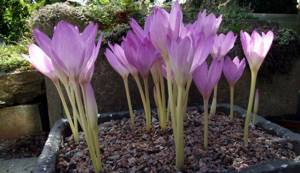
When planting such a plant in open ground, it is necessary to maintain a distance of 10–20 centimeters between the specimens. Small bulbs should be planted to a depth of at least 8 centimeters, and large ones - no more than 20 centimeters. When planting bulbs, you need to add wood ash to the soil (1 liter of substance per 1 square meter), as well as superphosphate (1 full large spoon per 1 square meter)
During planting, you need to pay special attention to the tubes on the bulb, which are formed by scales. They must definitely look out of the ground, as buds will subsequently appear from them
Such a tube should not be cut, since in this case the resulting bud will need to move apart a heavy layer of soil in order to get to its surface. Before planting, the soil must be prepared; for this, during digging, add half a bucket of sand and 1 bucket of humus per 1 square meter. Colchicums planted with bulbs begin to bloom after 1.5 months.
Colchicum planting dates
Colchicum has different flowering times, which depend on the plant variety. Therefore, when planting bulbs in open ground, you need to take this into account.
- Plants whose flowering period begins in spring should be planted in early to late summer. At this point, the bulbs and seeds are sufficiently mature and ready to be dug up. They can be replanted in the fall.
- Bulbs of varietal plants that bloom in autumn (the vast majority of them) should be stored in a cool place until next year and planted in the ground in August.
If you managed to purchase large and strong autumn-flowering specimens, they may even bloom immediately after planting.
But for this it is necessary that the weather is not rainy and warm. To maintain abundant flowering and the formation of baby bulbs in Colchicum, the plant must be replanted every 3 or 4 years.
Colchicum splendid: ancient healer
Colchicum is a perennial herbaceous plant belonging to the genus Colchicum.
It has many unofficial names:
- autumn colchicum;
- timeless color;
- pestilence saffron;
- colchicum;
- autumn;
- dog death.
This is a unique herbaceous bulbous plant, the healing properties of which were known to ancient healers. It was used as a medicine in both Ancient Egypt and Ancient Greece. Conducted modern research also proves its beneficial effect on the human body.

Colchicum magnificent photo
Description of the plant
Autumn usually grows in mountainous areas; it can be found on the slopes of the Caucasus, where from mid-summer to October beautiful large flowers bloom, painted in all shades of pink: from light to deep purple. After flowering, by spring, a fruit with seeds forms underground, and the growth of young green leaves begins. Because of this feature, in the Middle Ages the crocus was called “the son before the father.”
Chemical composition
The unique chemical composition of Colchicum splendid explains its beneficial properties.
It contains substances such as:
- alkaloids that belong to the heterocyclic series (colchicine, colchamine, colchicine);
- sugars and glycoalkaloids;
- flavonoids;
- aromatic acids and other substances.
Medicinal properties
The main active ingredients of Colchicum splendid are alkaloids. The substance colchicine stops the division of the cell nucleus, as a result of which the growth of both benign and malignant formations is blocked. If surgical intervention is not possible, such medications (tablets) help in the treatment of cancer of the esophagus or stomach. By applying preparations (ointment) containing colchamine to areas affected by a malignant tumor, you can effectively fight skin cancer. The beneficial components in the plant allow it to be used to treat rheumatism and gout. They help get rid of inflammatory processes in the intestines and stomach, and are also indicated for neuralgia and to improve blood circulation. Studies have shown that colchicum preparations have a laxative effect and help lower blood pressure.
Medicinal use
Colchicum bulbs are used in folk medicine. Harvesting should begin at the end of summer, selecting only large specimens. Normal collection time: from late August to September. The remaining soil is carefully removed from the bulbs dug up along with the roots (do not wash them!) and dried in the sun or in a warm, well-ventilated room. Bulbs can be stored for up to 3 years. Since the plant is very poisonous, all manipulations with it must be carried out with great care.
Recipes
To prepare the infusion
you need to take half a teaspoon of colchicum bulb (fresh) and pour boiling water (0.5 l). After two hours, strain the liquid. Drinking a few drops several times a day with a glass of water can reduce swelling and relieve pain due to rheumatism.
To relieve pain from arthritis and radiculitis
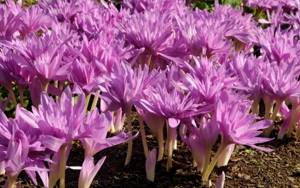
Colchicum splendid
An ointment can be prepared from the bulbs and the green part of the plant. Cut 300 grams of fresh raw materials and fill with water (0.5 l). Keep the mixture in a water bath for half an hour, then strain and add Vaseline to obtain a mass that is easy to apply. Use is contraindicated in the presence of skin cancer with metastases, as well as near mucous membranes. Penetrating through them, colhamine can produce side effects similar to those taken orally.
Rubbing can be used as a pain reliever:
Chop the dry onions and add vinegar (1:12) and leave to infuse for two weeks. Another option: Pour the crushed roots of the plant with 50% alcohol (1:5) and let the mixture brew for a couple of weeks.
Contraindications
The use of this medicinal plant must be coordinated with
Author of the article: phytotherapist-herbalist Cheremisin Vladimir Timofeevich
attending physician. Colchicum splendid is very poisonous, which precludes any self-medication
It is permissible to use products with it for external use on your own, taking the necessary precautions. Its uncontrolled use can only worsen health and even lead to death.
Useful properties of the plant and contraindications
The beneficial properties of Colchicum splendid have been studied quite well by pharmacognosy (the science of the medicinal properties of preparations based on plant and animal raw materials). The plant contains several alkaloids, the most valuable of which are:
- colchicerine;
- colchicine;
- speciosin;
- kolkhamin.
These are toxic substances characterized by antitumor activity. They are used to treat cancer of the esophagus and upper third of the stomach. Alkaloids also have anti-inflammatory effects. Therefore, decoctions and alcohol tincture based on Colchicum splendid are used to treat other diseases:
- stomatitis;
- phlebitis;
- gout;
- arthritis;
- chondrocalcinosis.
Attention! Since the alkaloids that make up the magnificent colchicum are poisonous, products based on it can only be used after consultation with a doctor.
During treatment, the following may be observed: decreased blood pressure, indigestion, and impaired hematopoiesis.
Collection and preparation
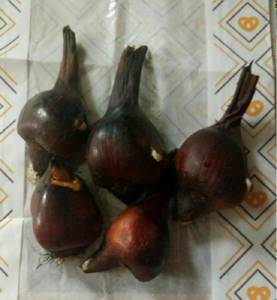
The corms of Colchicum splendid are used for medicinal purposes. They are harvested at the flowering stage, i.e. from the last ten days of August to the first half of October (depending on the variety). The bulbs are carefully dug up, being careful not to damage them, as they can rot and become moldy. Then they are cleared of soil, leaves and flower stalks are removed, washed in warm water and laid out in one layer.
You can dry it under a canopy (if the weather is warm) or in a ventilated area, avoiding direct contact with sunlight.
After 1-2 weeks, the bulbs will be completely dry, but will still have an unpleasant odor (which is normal). They are crushed and stored in a dry, cool place for up to four months.
Attention! You only need to work with bulbs while wearing gloves.
After this, hands are thoroughly washed with soap to avoid poisoning.
Colchicum splendid
Colchicum speciosum Stev. Description Colchicum splendid is a perennial herbaceous plant of the lily family. The flowers are large, lilac-pink, less often almost white, odorless. Perianth limb with 6 broadly oval lobes, 6-10 cm in diameter, perianth tube length 25-40 cm. Leaves 4-5 (rarely 3 or 6), they are large, oval-oblong, 25 cm long, up to 5 cm wide. Fruit - three-cavity box; the seeds are round, brown, up to 2-3 mm in diameter. The peduncle of the plant is shortened, hidden in the corm and bears 1-3 flowers. The flower has a simple cleavage perianth with a very long tube, the base of which is also hidden in the corm; at the top, the perianth expands funnel-shaped, forming 6 lobes. There are six stamens, one pistil with three styles and stigmas, the ovary is three-locular. The ovary is located at the base of the tube inside the bulb, underground. Before frost, pollination of the flower has time to occur, and after the above-ground part has withered, the ovules slowly develop underground in the ovary and the fruit begins to form. That is why in the spring the young fruit (three-lobed multi-seeded capsule) is born so quickly along with the young leaves. Colchicum splendor translated from Latin means “son before father,” since the fruits seem to appear before the flower: in the spring the leaves come out of the ground, and a developing green fruit hides between them. Almost no one noticed when the plant bloomed; a fruit can only develop from a flower. The fruit grows, turns brown and scatters seeds in June-July, after which the leaves die. If you visit this place in the summer, you will not find any traces of the plant above the ground. But in late autumn (September-October), the entire lawn with colchicum is covered with beautiful pink flowers without leaves or stems. But after some time, from the beginning of frost, the flowers will die before they have time to produce a seed. However, digging up the ground in the fall, you can see many succulent corms with numerous thin roots, covered with dark brown membranous membranes. Harvesting For medical purposes, only large corms (at least 4 cm long and 3 cm in diameter) are harvested
They are dug out together with the roots carefully, without causing damage: damaged corms easily become moldy and rot during storage. Undamaged corms are cleaned of soil, dried, laid out in a thin layer (up to 10 cm) in a sunny place or in a well-ventilated, warm, dry room.
The entire plant is poisonous, so care should be taken when harvesting. To preserve natural thickets of colchicum, at least 10-20 flowering plants per 100 m2 of thicket should be left as seed plants, and repeated harvesting in the same area should be carried out no earlier than after 4-5 years. Chemical composition of crocus colchicum contains alkaloids, the main of which are -colchicine and colchamine. Colchamine has the same effect as colchicine, but is less toxic. Pharmacological properties Colchicine has the ability to delay the division of the cell nucleus. Use in medicine Used for endophytic and exophytic forms of skin cancer stage I and II, for cancer of the esophagus, stomach (in combination with sarcolysine) in cases not subject to surgical treatment, as well as in cases of gout. Based on the theory that substances that retard the division of the cell nucleus can also retard the growth of tumor cells, medical experts began to use colchicine to treat skin cancer. Medicines Colchamine is used in the form of a 0.5% ointment (omaiic ointment) for the treatment skin cancer. Contraindications Self-medication with colchicum is life-threatening. A little history Colchicum is one of the most ancient medicinal plants. Information about it is available in written sources of Ancient Egypt, India, and Greece. In the Middle Ages in Europe, an infusion of colchicum seeds and tubers was used as a medicine for gout, rheumatism, neuralgia and as a diuretic. In 1618, Colchicum was included in the first British Pharmacopoeia. Places of growth Colchicum splendidly is distributed throughout the main Caucasian ridge, as well as in the mountains of Western Transcaucasia. Eastern Georgia.
Do I need to dig up colchicum bulbs?
There is no need to dig up tubers every year. Tubers that have grown a sufficient number of “children” must be dug up. As a rule, this happens after 3-5 years of plant growth in one place. Due to crowding, the flowers become smaller, or flowering stops altogether.
You need to dig up the bulbs when the leaves begin to wither. This approximately occurs in July or early August. There is no need to wait until the leaves are completely dry. Because dry leaves are easily separated from the bulb and there is a high probability of losing the bulb in the ground. The leaves serve as a kind of marker for finding bulbs.
Reproduction of Colchicum
Any summer resident or gardener can plant and care. To propagate colchicum, bulbs and seeds are used. The easiest way is with young bulbs.
Important! Since it is poisonous and can cause burns, you must wear gloves when working.
Bulbs

Material for planting is purchased in a store or market, or you make it yourself. When preparing yourself, follow some subtleties:
- dig up very carefully, without damaging the skin;
- washed without breaking the scales that cover the outside of the bulb;
- place water with potassium permanganate or in a weak solution of potassium permanganate;
- dry in a dark, cool room;
- prepare the soil and plant.
The optimal time for planting colchicum bulbs is the 20th of August. Before planting, prepare the soil: 5 liters of humus or manure per 1m2 and ½ bucket of river sand. Lightly dig up the soil. At the time of planting, add fertilizer - 1 liter of wood ash and 1.5 dess. spoons of superphosphate per 1m2.
The onions are planted at intervals of at least 20 cm in holes 15 cm deep. Then they are thoroughly watered and covered with foliage.
Seeds
When they want to plant more flowers, they use seeds. Planting autumn crocus flowers with seeds is not easy work. Firstly, the seeds need to be cooled in advance, for example, in the refrigerator, in a damp rag. Secondly, soak. Thirdly, only flowers that bloom in spring are planted in this way. The peduncle appears no earlier than 7 years. Growing using this method has one advantage - the plant will grow healthy.
In spring, the seed pod begins to form. In summer it completely ripens and dries out. Then it crumbles and the seeds randomly fall to the surface of the soil. During this period they are collected. Select a seed pod that has just begun to darken. It is cut off and placed in a cool, well-ventilated place to dry. Planting material is not stored for a long time; it is used immediately.
The seeds are soaked and left for several days. They are washed 1-2 times a day. Prepare small holes for sowing: first water the ground, then make 3-5 cm deepenings. Throw seeds into the holes and cover them with earth. Irrigate regularly. They do not require any other special care. The next year, in the spring, seedlings appear. The soil under them needs to be loosened and watered. Thin out the seedlings once.
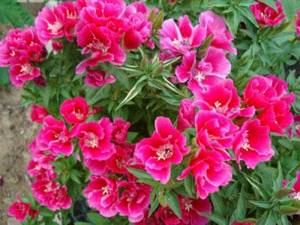
You may be interested in:
Godetia: growing from seeds at home Godetia is an attractive flower that should definitely be on your site. He will delight with his beauty...Read more...
Colchicum is planted in the fall, but it is possible to store the seeds in the refrigerator until spring. Using this planting method, a plant grows absolutely healthy and of a certain variety.
Reproduction
There are several ways in which the plant can be propagated. One of them involves the use of seeds, the second – bulbs.
Seed method
The plant that grows from the seed blooms only in the fifth year of life, so this method of propagation is used in rare cases. Seeds begin to be collected in mid-summer and are immediately planted. Store the seeds for no more than five days in the refrigerator. The soil should be fertile and slightly moist. The seeds are pre-soaked in water and then sown. Water the soil periodically. The first sunrises can be observed in spring.
The root way
In mid-summer, the bulbs of an adult plant are dug up. The soil in them is removed; it is not recommended to touch the scales. The bulbs are soaked in a solution of potassium permanganate for half an hour, then dried and placed in a dark and cool place.
In August, the bulbs are planted to a depth of twelve centimeters, the soil is pre-fertilized. The distance between the bulbs should not be less than twenty centimeters. After four years, the plant must be replanted.
Growing autumn colchicum in the garden
Let's find out in more detail how to grow it on your site and what kind of care is needed for this beautiful, perennial colchicum flower, scientifically called Colchicum autumnale. The roots of the Colchicum flower are tuber-bulbous. The leaves are wide and large or oblong (shape depends on the variety). The flowers are funnel-shaped, white, pink with a purple tint or lilac. In the spring, the autumn colchicum decorates the garden clearings and flower beds with its rich, juicy green leaves, then the plant withers. Colchicum blooms in the fall - in September and October, decorating the garden with flowers, when all the bulbous and lily plants have already faded. Therefore, a delicate flower that blooms not when everything else has received its name is colchicum. After flowering, a fruit is formed in which the seeds ripen by next summer.
- It prefers to grow and bloom on loamy soils that are moist and nutritious.
- Add distillate (1 part) and sand (0.5 parts) to the planting site.
- Tolerates both shade and sun well.
- This delicate, perennial flower is a winter-hardy plant, which gardeners love - there is no need to dig it up for the winter, and if your winters are still severe, then cover the spruce with spruce branches and the colchicum will overwinter well.
- Colchicum is propagated by seeds and tubers.
- Seeds are sown in the fall, since if sown in spring they will take a year or longer to germinate. But colchicum grown from seeds will bloom only in 6-7 years.
- We plant tubers (bulbs) in the flower beds of the garden, seeing that the buds have hatched - at the end of August, beginning of September (depending on the region and weather), deepening them into the soil to a depth of about 10 cm and at a distance of about 15 cm from each other.
- Colchicum lives in one place for a long time and it is better not to touch it (not replant it) for 3 years, and in the 5th - 6th year of flower growth it’s time to dig it up and plant it.
When to dig up colchicum
In order to replant colchicum, the tubers are dug up in the summer - in the yule or in early August after the plant has withered. After you have dug up the tubers, gently remove the old roots and leaves and let the corms dry in the wind a day and store them in a dark place, but not in the basement since the storage temperature of the tubers is 20-23 degrees C.
Once you divide and plant this attractive fall-blooming bulbous plant, its flowers will be brighter and stronger. Young, newly planted baby bulbs will give you their flowers the next year, and if the quality is good, already in the year of planting.
Perennial care
Since autumn crocus is a tuberous plant, it requires regular weeding.
- This is especially necessary to do during flowering and in the spring, when the plant begins to grow.
- Water the flowers as needed to keep the soil moist all the time.
- In gardens, the perennial autumn flower Colchicus is planted on the south side near a group of herbaceous plants, shrubs, and next to other bulbous flowers.
- DIY rosary: how to make
- Planting a standard rose and care
Growing colchicum: choosing a location and care rules
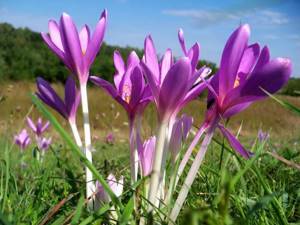
Colchicum plant photo care and cultivation in open ground
Autumn is surprisingly unpretentious to conditions. Prefers moist and oily soil. Without transplantation it can grow for 5-6 years. If it stops blooming, this means that too many young daughter bulbs have formed in the nest and the plant should be replanted. It is usually placed in a sunny or shaded place. An ideal place for planting is under garden trees.
In spring, colchicum leaves appear at a time when trees do not provide much shade. The sun is enough for him. And with further opening of the leaves on the trees, the foliage no longer needs a lot of light, because By this time it is already beginning to fade. The soil for planting should be light, loose, and moderately nutritious. Almost no watering is required. In the spring, when the leaves are developing, there is still enough spring moisture. In summer the plant sleeps. In autumn, in the absence of rain, water carefully, trying not to wet the flowers - once they get wet, they quickly lose their shape.
Feeding and watering colchicum
They are fed in the spring when the leaves appear with nitrogen fertilizers - this helps to form large and strong leaves, which in turn will allow the bulb to be saturated with useful substances and accumulate strength for future flowering, and in the fall after flowering - with a complex fertilizer or sprinkled with organic matter, followed by loosening.
Don't water in spring. The soil is quite moist after the snow melts. By the beginning of summer, the growing season of the crocus ends - the plant falls asleep. He does not need moisture at this time. When flowering, if there has been no rain, water once a week.
Features of Colchicum

Such a herbaceous plant is a perennial, and it is also an ephemeral. It has a large number of short shoots, on which large lanceolate-elongated leaf plates are located. They grow and develop during the spring, and by the beginning of the summer period they completely die off. On the surface of the corms there is a brown shell. This shell forms a long tube that covers the lower part of the flower. Most species of colchicum bloom in spring. However, in some species flowering occurs in the spring. Single funnel-shaped flowers grow from the soil. The length of such a flower, together with the perianth fused into a tube (most of it is located under the surface of the soil), is 20 centimeters. The fruit is a three-locular oval spherical capsule. This plant contains poison; Dioscorides himself mentioned this in his works. It should be remembered that the poison is found in any part of this plant.
Description of the plant Colchicum or Colchicum

Colchicum flower Colchicum photo and description of the plant
A beautiful perennial plant from the Colchicum family. It is an ephemeroid - perennial herbaceous plants with a very short growing season. The stem is erect, bare, low, 10-30 cm long, depending on the species.
The root is an oblong-oval corm, covered with a brownish-brown leathery shell. Large bright green oblong-lanceolate leaves 25-30 cm long appear in early spring, simultaneously with the fruits. They look like lily of the valley or wild garlic leaves. During the growing season, they must feed the bulb with nutrients.
The flowers are solitary, large, bell-shaped, funnel-shaped, with pointed or rounded petals that remain half-closed or completely open, displaying brightly colored stamens. Color ranges from white to pink-lilac and purple. Colchicums bloom in late summer or autumn for about 2 weeks. Bees and flies pollinate flowers at this time. After flowering, the fruit appears next spring - a three-locular elliptical capsule. When the fruits ripen, the leaves die off (May-June).
On the territory of Russia, under natural conditions, they are distributed in the Caucasus and Krasnodar Territory; in culture - in areas with a temperate climate.
Colchicum care
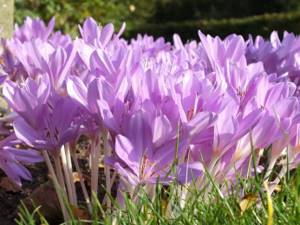
There is nothing difficult in caring for such a plant. Watering should be done only when the plant is blooming, and then this should be done only during periods of prolonged drought and heat. At other times, such a flower should not be watered, because natural precipitation will be enough for it. Remember to avoid over-wetting the soil.
Feeding is done 2 or 3 times per season. To do this, use complex mineral fertilizer (30 grams per 1 square meter), and prepare a weak solution (2 grams of substance per 1 liter of water). Remember that the fertilizer must contain nitrogen. In autumn, compost should be added to the soil. It is also necessary to systematically loosen the soil surface and remove weeds.
How to transplant

This flower can be grown in the same place for quite a long time (about 6–7 years), then it must be transplanted to a new place. However, experienced gardeners advise replanting at least once every 2 or 3 years, otherwise the bulbs will grow and become very crowded, and the flowers will become smaller.
The best time for both planting and replanting such a plant is August. At this time, the crocus is at rest. However, the bulbs must be dug up in advance, after the leaf blades turn yellow, as a rule, this time occurs in the second half of June. You need to carefully remove the soil from the bulbs, and also remove the remaining leaves. Separate the daughter bulbs from the mother bulbs, keeping in mind that the latter are not used for subsequent planting. Then the bulbs should be carefully washed in running water, after which they are placed in a solution of potassium manganese for disinfection for 30 minutes. Then the tubers need to be thoroughly dried and stored in a dry, dark place, while the air temperature should be approximately 24 degrees. With the onset of August, the separated daughter bulbs must be planted in the ground. In this case, the planting rules are exactly the same as those used for planting colchicum (described above). At the same time, do not forget to fertilize the soil first.
Diseases and pests
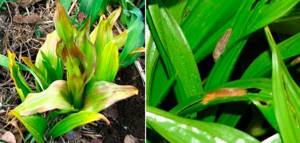
Snails and slugs can live on such a flower. Such pests feed on its leaves. If the soil is almost constantly waterlogged, this can cause the development of gray rot. In order to avoid the appearance of slugs, the surface of the rows must be covered with a layer of crushed shells, fine gravel or egg shells. You can also place plastic gutters around the perimeter of the site into which you need to pour water. They will become an insurmountable barrier for slugs and snails.
If the crocus is regularly watered abundantly for a long time, gray rot, which is a fungal disease, may appear on it. If the flower is not very infected, you can try to cure it. To do this, it is recommended to treat the bush with Champion, Topaz, Kuproxat or another product with a similar effect. Before treatment, those parts of the plant that are severely affected should be cut off and burned. Then you need to reconsider the watering schedule.
Diseases and pests
The plant has natural immunity from fungal and other infections, and practically does not get sick if the soil is not waterlogged. With high humidity, leaves and tubers can be affected by various rots.
Try to protect the plant during periods of prolonged rain, especially in hot weather, but if infection occurs, you cannot do without fungicides. Cut out the affected areas of the leaves and treat with Fundazol or Oksikhom. After 2 weeks, repeat spraying.
The greatest and most likely danger to colchicum are slugs and snails, which like its succulent leaves. There are several options for pest control:
- they set traps with bait and then physically destroy the individuals;
- treat the leaves with anti-mollusc drugs: Methiocarb, Metaldehyde.
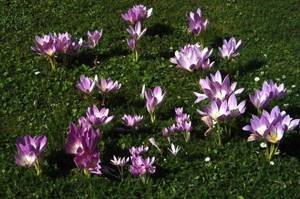
Everyone can choose the method that is available to them.
Care
Taking care of colchicum is not difficult, and the whole range of measures is kept to a minimum, however, you should familiarize yourself with the basic procedures for successful cultivation:
- Watering. Only needed once a week during flowering and only if the weather is hot. Excess water is harmful to the plant. To get rid of stagnant moisture during a thaw, grooves are made around the tuber through which water will drain, and the soil is cleared of snow.
- Fertilizer. A mandatory condition only during planting, the rest of the time it is rarely required (simple varieties feel great without fertilizing): in spring and autumn. For intensive growth in spring, you can use nitroammophoska (40–50 grams per square meter). In the fall, fertilize with compost.
Weeding, removing faded buds and dried leaves. This procedure prolongs the decorative effect of the flower.
Preparing for winter
It is especially important to cover weakly winter-hardy varieties. For the winter, they are covered with dry leaves, rotted manure, garden compost (the optimal layer is 10–15 cm) or non-woven material.
Seating
The flower must be thinned out (planted) regularly and in a timely manner. Otherwise, if there is a large accumulation of tubers, the colchicum will enter the vegetative phase and stop blooming. Replanting is carried out once every 2-3 years after the final death of the foliage (mid-summer - early September). Colchicum tubers are dug up, cleared of soil, dried and planted in a new place. If the soil has not been changed, it needs to be enriched with humus (compost) mixed with a small amount of sand. The depth of the hole should be three times the diameter of the bulb, and the required distance between flowers should be 15–20 cm.
Colchicum leaves should not be trimmed - they should turn yellow and dry out on their own.
Important! All parts of the colchicum are poisonous, so work must be done with gloves.
The special life cycle of the crocus
Colchicum grows according to its own special cycle. Therefore, when planting its bulbs for the first time, a novice gardener will be puzzled by the result. In the spring the plant will have leaves, but in June they will wither and dry out. Then in September, delicate flowers with a charming aroma will suddenly appear from under the fallen leaves. They please the eye for 2-3 weeks, then they dry up, and the crocus goes into a dormant state until spring.
The fact is that this flower belongs to ephemeral plants that can adapt to natural cycles. In the homeland of the crocus, he had to fight for survival due to the oncoming drought. Therefore, it tolerates the summer heat in the form of bulbs, and in the fall, when favorable conditions occur, it blooms.
In spring, the plant produces green shoots with leaves. At the same time, a fruit appears from last year’s ovaries, in which the seeds ripen. Thanks to photosynthesis, the bulb stores nutrients for the coming year.
Varieties
Before we begin to describe the popular varieties of Colchicum splendid, let's get acquainted with its forms.
- Colchicum speciosum f. album – white form. The flowers are large, snow-white.
- Colchicum speciosum f. atrorubens – dark red form.
- Colchicum speciosum f. ordu. The flowers of this form are smaller than the others, the petals are narrower, and the color in the center is snow-white.
- Colchicum speciosum f. dombai or Dombai form. Almost identical to the previous one, however, the flowering period begins later.
- Colchicum speciosum f. giganteum or giant colchicum. It was named so because of the size of the bulb. The color of the petals is light lilac, the core is white, the perianth is cup-shaped.
- Colchicum speciosum f. turkey – Turkish form. It has goblet-shaped flowers of a bright lilac hue, white in the middle.
- Colchicum speciosum f. rubrum - differs from others in its large red flowers.
- Colchicum speciosum f. veratrifolium or hellebore form. It has folded leaves and large lilac flowers.
Well, now it’s time to get acquainted with the varieties of the magnificent colchicum. Most of them are obtained by hybridizing this species with others. First, let's look at those that bloom in the first half of September.
- Autumn Queen. The height of the flower is up to 25 cm. The petals have a dark purple tint, decorated with a “checkerboard” pattern, and the core is white.
- Beaconsfield. The stem does not exceed 25 cm in height, the flowers are bright, purple, with burgundy anthers and a variegated pattern. Flowering is abundant.
- Violet Queen. It grows up to 20 cm in height, has bright lilac flowers with a “checkerboard” pattern and orange stamens.
Varieties that bloom throughout September.
- Antares. The height of the plant is 20 cm. The flowers are large, the petals are light purple on the outside, and white on the inside with light lilac tips.
- Attlee. It also does not exceed 20 cm in height. It has purple flowers with a white core.
- EA Bowls. Rare variety. The stem is 20 cm in the form of a purple tube, the petals are pale lilac, greenish-white in the middle.
- Gracia. Grows up to 20 cm in height. The flower's petals open wide and have purple petals that turn white toward the center.
- Jarka. The stem is 20 cm. The flowers are pinkish-lilac, the petals taper to the tips and become white.
- Lilac Bedder. Plant height – 20 cm. The flowers are pale purple, the center is white.
- Poseidon. A low-growing variety - only 15 cm in height. The stem is thickened. The petals are painted mauve, the color is uniform, the anthers are reddish.
- Zephyr. Grows up to 25 cm. The flowers are purple, the middle is white-green.
Now it’s the turn of the varieties that delight the eye in the second half of September.
- Glory of Heemstede. The stem does not exceed 20 cm in height. The flowers are quite large, lilac-pink, variegated, with a white core.
- Harlequin. Recently bred variety. The green tube-shaped stem grows up to 20 cm in height. The petals are lilac, the center is snow-white. The tepals are folded inwards.
- Lilac Wonder. Plant height is up to 20 cm. The flowers are pinkish-lilac, variegated, the petals are elongated and narrow. The flowering period is quite long. One bulb can produce up to 20 flowers.
- Waterlily. Terry variety, very loved by gardeners. Stem height is 20 cm. The flowers are lush, with narrow pink petals up to 15 cm in diameter.
Late flowering varieties.
- Dick Trotter. Flowering begins in late September - early October. The petals are round, bright purple up to the middle, becoming greenish-white towards the center. The anthers are yellow. Plant height – up to 20 cm.
- Giant. The latest variety, its time is October. The flowers are large, pale lilac, white in the middle. The stem is tube-shaped, pale green. Height – 25 cm.
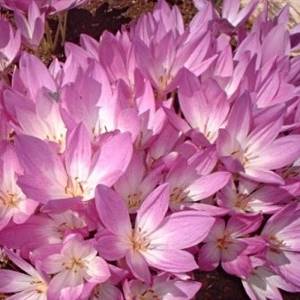
Varieties and types of colchicum
Today there are more than 70 species of this plant. But only four varieties are popular in our country. We'll take a closer look. Let's talk in more detail about those varieties that gardeners love most.
Autumn
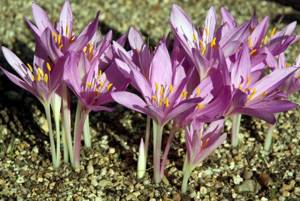
This perennial begins to bloom most often at the end of August. Sometimes - at the beginning of September. In this case, the formation of the future flower begins in the spring, when leaves begin to appear on it. Usually these are eight narrow leaves that grow up to 25 centimeters in length. Over time they die off. And closer to autumn, the formation of flower stalks begins. As a rule, each bulb can have up to six peduncles of pink or soft lilac color.
Variety Regel, or Rigel
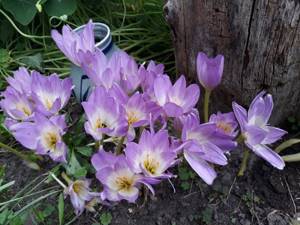
This variety cannot be found in Russia. Since it grows mainly in an alpine climate, at an altitude of more than two thousand meters above sea level. It can also be found in the Pamirs and the Tien Shan mountains.
The species has an oblong bulb, as well as from two to seven leaves. They are usually blunt in shape, the edge can be jagged or completely smooth. The flowers are usually white with purple or violet stripes. The plant begins to bloom immediately shortly after the snow melts. From one to four flowers can come out of one bulb.
Fabulous
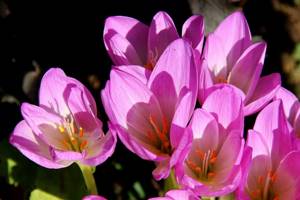
This variety blooms in autumn. But already in spring leaves begin to appear on it. In summer they die and fall off, and flower stalks appear in their place. Their height reaches 20 centimeters. Flowers can be either pink or white. The shape is very interesting, reminiscent of a glass.
Cilician
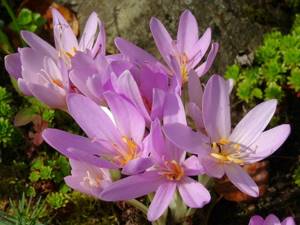
Externally, the plant resembles crocuses. But its difference is that flowers appear not in spring, but in August. Sometimes even in September. The flowers remain open for quite a long time, up to about three weeks. Like other species, leaves appear on the flower in the summer, which soon die off.
Byzantine
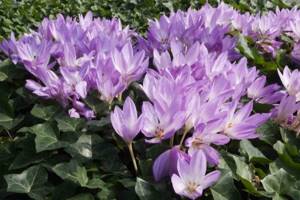
This perennial is not very tall - it usually grows no higher than 20 cm. Flowering begins in the fall. But the most important thing why flower growers love this plant is its rich range of colors. Flowers can be either lilac, pink or white.
Yellow
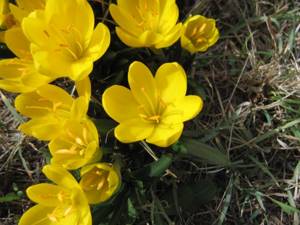
The most important difference between this variety is that the plant blooms in the spring. The homeland of the variety is the rocky regions of the Tien Shan mountains, as well as the Himalayas. You can also find this flower in the Pamirs or Tibet.
As soon as the snow melts, this plant begins to bloom. The diameter of these rich yellow flowers is not large - up to three centimeters in diameter. The height of each stem is up to 15 centimeters. The leaves are flat and develop at the same time as the flowers.
Reproduction of crocus
Colchicums can be propagated by seeds and by dividing nests of bulbs. The latter are sometimes formed in very large quantities and take away all the strength, which leads to a lack of flowering. If your colchicums have not bloomed late in the season, this is a sure sign that they need division. The best time for it is considered to be July, immediately after the complete death of the above-ground part. The corms are slightly dried and not stored for storage, but planted immediately.
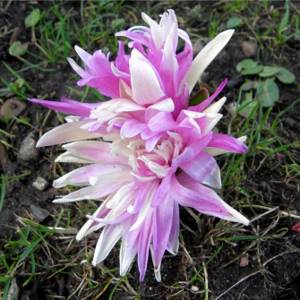
Colchicum hybrid. © Irenicrhonda
Colchicums obtained from seeds bloom after 5-7 years. Seeds are sown after collection, fresh, in June or July, and seedlings will appear only a year later in the spring. This method is only suitable for wild-growing colchicums.
